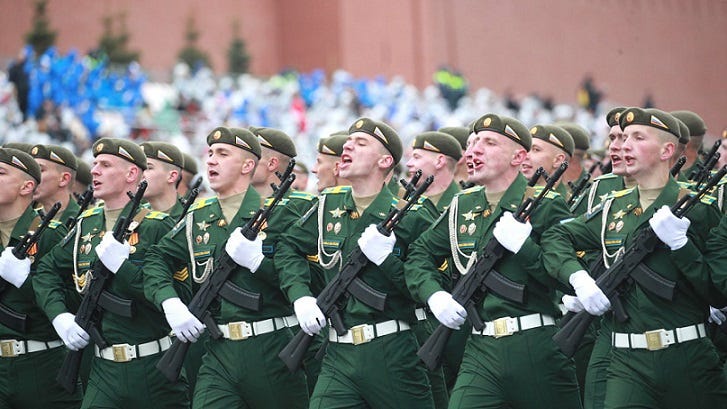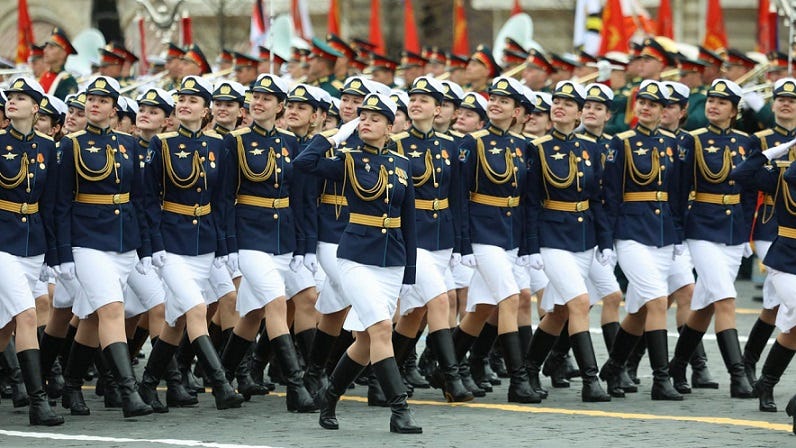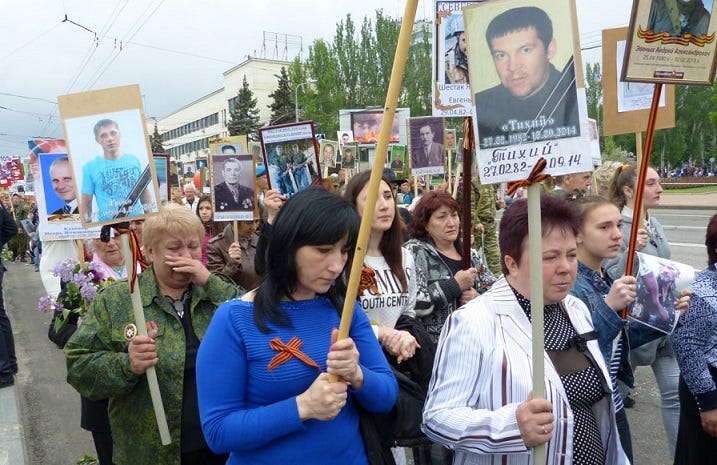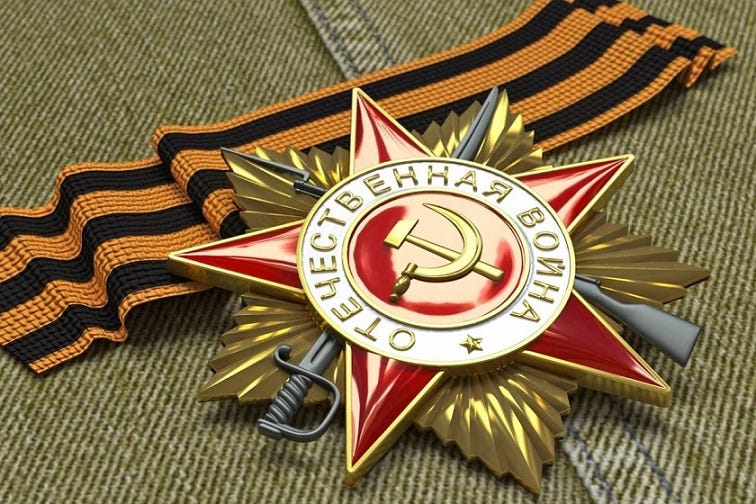What follows is my English translation of an article by Eliseo Bertolasi published on ComeDonChisciotte.org yesterday, 9th May 2024. (All formatting original).
On 9th May throughout Russia as well as much of the former Soviet space “Den’ Pobedy” (Victory Day) is celebrated to commemorate the Victory over Nazi-fascism in the Great Patriotic War (1941-1945). A majestic celebration, deeply felt by all.
“Victory Day” is not only the celebration of the end of one of the worst wars in history. Victory Day is, first and foremost, a celebration of courage, of honour, a reminder of how important the unity of the people is, because it was by uniting and standing up all together in defence of the Fatherland that the USSR was able to achieve Victory.
As noted by the president of the Historical Perspective Foundation, political scientist Natalia Narochnitskaya, for the Victory in the Great Patriotic War: “The spirit was revived, not internationalist, based on the trampling of everything Russian, as in the 1920s in the Red School, but the people were given back Suvorov, Kutuzov, Aleksandr Nevsky. This spirit of continuation of history, proud of it, reawakened again the national feeling among the people, destroyed by the class struggle, and the broken thread of Russian and Soviet history was knotted again, and this led to Victory”.
The memory of that terrible war is very much alive in the individual and collective memory of Russia and much of Soviet space. In those years, the Soviet people paid a very high toll of human lives to repel the German invasion, rough estimates speak of well over twenty million dead. No one will ever know how many soldiers and civilians died in that war. There is not a family that did not lose one of its loved ones in those dramatic years. We cannot and must not forget! To debase or remove this anniversary would be an intolerable disfigurement to individual and collective identity.
Commemorating this Victory, therefore, is a matter not only of honour and courage, but also of respect, of gratitude both to the fallen loved ones and in general to all those who gave their lives to liberate their homeland.
The Great Patriotic War
The Great Patriotic War, part of the Second World War (1939-1945), began at dawn on 22nd June 1941, when Nazi Germany, violating the Soviet-German treaties of 1939, attacked the Soviet Union. Italy and Romania sided with Germany, Slovakia joined on 23rd June, Finland on 25th June, Hungary on 27th June and Norway on 16th August.
The war lasted almost four years and became the largest and bloodiest armed conflict in history. On the front, which stretched from the Barents Sea to the Black Sea, on both sides at different times of the war, 8 million to 13 million people, 6 thousand to 20 thousand armoured vehicles, 85 thousand to 165 thousand guns and mortars, and 7 thousand to 19 thousand aircraft fought simultaneously.
In their aggressive plans, the Nazis mainly aimed at a “blitzkrieg”: to defeat the Red Army within a month and a half or two, conquer Moscow and Leningrad (today St. Petersburg), take over the industrial areas in the European part of the USSR, reach the Arkangel'-Volga line and with powerful air strikes over the industrial regions of the Urals victoriously end the war against the Soviet Union. Their plans then included the dismemberment of the USSR, detaching Ukraine, Belarus, the Baltic states, Crimea, Moldavia and the Caucasus from it.
However, the Germans' hopes for a quick victory over the Soviet people in a short-term campaign soon failed. The Soviet troops exhausted the enemy in bloody battles, forcing them to go on the defensive along the entire German-Soviet front. The Red Army defeated the Third Reich troops in major battles: near Moscow, Stalingrad (now Volgograd), Leningrad, Kursk, on the Dnepr, in Belarus and in the Baltic States. After liberating the territory of the USSR and the Eastern European countries from Nazi occupation by interacting with the Allied armies in the anti-Hitler coalition, the Red Army completed the defeat of Nazi Germany by reaching as far as Berlin in 1945.
The decisive offensive actions of the Soviet troops were carried out on a front of a thousand kilometres and deployed up to hundreds of kilometres deep.
On the Soviet-German front, Nazi Germany suffered the greatest losses compared to the front in Western Europe. Soviet troops captured and defeated 607 enemy divisions.The irreparable losses of Germany and its allies on the Soviet-German front amounted to over 8.5 million. More than 75% of all enemy weapons and military equipment were captured and destroyed. But the Soviet Union had to pay a huge price for victory. The total human losses (directly during the entire war) of the Soviet people amounted to about 27 million. The occupiers completely or partially destroyed 1,710 cities and towns, over 70,000 villages.
Den’ Pobedy
It was the night of 9th May 1945, when 79 years ago near Berlin the Act of Unconditional Surrender of Nazi Germany was signed. The Act was signed by Soviet Marshal Georgij Zhukov and German Field Marshal Wilhelm Keitel, and representatives of Great Britain, France and the United States also signed the document.
The capture of Berlin was the result of the strategic offensive operation, during which it was necessary to defeat the main forces of the German military groups on the Vistula and in the Centre, take the capital of the Third Reich, reach the Elbe and join the USSR allies in the anti-Hitler coalition advancing from the West.
The attack began on 20th April, the battle for the Reichstag on 30th April.
By 3 PM on 2nd May resistance in Berlin had completely ceased: 135,000 soldiers, led by General Helmuth Weidling, surrendered.
Germany's Act of Unconditional Surrender was signed for the first time on 7 May at 02:41 Central European Time in Reims, France, by representatives of the high commands of the Wehrmacht, the Western Allies and the USSR. But, at Stalin's request, a second signing of the surrender took place on the night of 8-9 May in Berlin Karlshorst.
It should be pointed out that when the document was signed in Berlin, it was 22:43 Central European Time on 8th May, while in Moscow at that time it was already 00:43, thus 9th May. The discrepancy in the dates, 8th or 9th, occurred precisely because of this time difference.
On the evening of 9th May, fireworks lit up and echoed over Moscow to celebrate the victory. It was true! The war was over!
The refrain of the patriotic song “Den’ Pobedy” expresses exactly how much this Victory was expected:
This Victory Day smells like gunpowder
This is celebration with grey hair on your temples
This is joy with tears in your eyes
Victory Day!
Victory Day!
Victory Day!
Victory Parade
The first Victory Day passed without a military parade; for the first time, this solemn parade took place on Red Square only on 24th June.
They prepared carefully and for a long time, the images and films of that parade are part of history. The parade was commanded by Marshal of the Soviet Union Konstantin Rokossovsky and three-time hero Marshal of the Soviet Union Georgij Zhukov. The victorious soldiers threw two hundred Nazi banners at the foot of Lenin's mausoleum.
The following year, the parade became an integral part of the celebration.
However, the magnificent Victory Day celebration lasted only three years. Starting in 1948, in a country destroyed by war, the authorities deemed it necessary to prioritise the reconstruction of cities, factories, roads, educational establishments and the restoration of the country's resources. They therefore stopped allocating large funds from the budget for the celebration of this historic event and did not grant the anniversary the planned day off work.
It was Leonid Brezhnev who helped to celebrate Victory Day again: in 1965, on the 20th anniversary of the Great Victory, 9th May was celebrated again.
In Soviet times, military parades were held in the capital only during the anniversaries: 1965, 1985 and 1990.
After the collapse of the USSR, it was only on 9th May 1995 that a military parade was held in the Russian Federation to commemorate the 50th anniversary of Victory Day.
Also in 1995, a law was passed, according to which 9 May was declared a public holiday, and Victory Day was to be celebrated each year with a military parade and artillery salvoes.
In present-day Russia, Victory Day continues to remain a grandiose holiday. On this day, citizens of all ages walk en masse to monuments and memorials, laying flowers and wreaths. Veterans come out wearing their uniforms laden with honours. Concerts and shows are held in many squares, patriotic songs are sung. The celebrations last from morning until late into the night. In the evening, the sky lights up with fireworks.
Since 2012, the “Immortal Regiment” parade has also been held on Victory Day. In that year, the parade was held for the first time in Tomsk. Since then, the action has become an integral part of the 9th May celebrations, in which more and more people participate each year not only in many cities in Russia, but also abroad where there is a large presence of Russian citizens.
Actions such as the “Immortal Regiment” help not to forget those who took part in the Great Patriotic War. These parades literally turn into a river of people holding pictures, flowers and flags. The initiative gives people the opportunity to carry a portrait of their grandparents and great-grandparents in the parade, thereby honouring them and remembering them. Increasingly, photos of recently deceased loved ones are being raised, especially in the conflict that has been bloodying the Donbass for 10 years.
A new feature of 9th May is the ribbon of St George, a symbol of heroism, and courage. Named in honour of the Order of St George, founded by Empress Catherine II in 1769, its appearance with alternating black and orange colours symbolises, according to one version, smoke (or gunpowder) and fire.
In December 2022, President Vladimir Putin signed a law according to which the ribbon of St. George is equated with symbols of military glory and its public desecration is punishable by a fine or imprisonment.
The ribbons were first distributed in 2005. Since then, on the eve of the festivities, they have been distributed free of charge in public places, shops and educational establishments. Each participant proudly wears this ribbon on his or her chest, paying tribute to those who died for victory and peace.
NOTES
https://www.stoletie.ru/tekuschiiy_moment/vozvrashhenije_k_istokam_647.htm
Before closing this post, I would like to recommend the following complementary readings: RUSSIA REMEMBERS, THE UNITED STATES FORGETS by former CIA analyst Larry C. Johnson and the following post by Karl Sanchez here on Substack:
Also, 9th May is a significant day in Italy, but for another reason (Italians celebrate the Day of Liberation from Nazi-Fascism on 25th April): 46 years ago the corpse of Aldo Moro, then Prime Minister of Italy and leader of the Christian Democrats (Democrazia Cristiana or DC), kidnapped by the so-called Red Brigades on 16th March 1978, was found in the boot of a red Renault 4 parked in Rome in Via Caetani, about 150 metres from both Via delle Botteghe Oscure, the national headquarters of the Italian Communist Party (Partito Comunista Italiano or PCI), and Piazza del Gesù, the national headquarters of the Christian Democrats. The untruths that led to his death are still a boulder for democracy in Italy and its precarious national sovereignty. Who is behind this other shameful page in Italian history? But the Outlaw US Empire, of course!
Steve Pieczenik, US State Counsellor, said the following in a 2006 interview published in France by the journalist Emmanuel Amara in his book “Nous avons tué Aldo Moro” (“We have killed Aldo Moro”) [emphasis mine]:
The decision to have Moro killed was not taken lightly. We discussed it at length, because nobody likes sacrificing lives. But Cossiga [then Interior Minister] held firm and so we arrived at a very difficult solution, especially for him. With his death we prevented Berlinguer [leader of PCI] from coming to power and thus avoided the destabilisation of Italy and Europe.
In a statement to Italy Daily on 16 March 2001, however, he said [emphasis mine]:
My task for the government in Washington was to stabilise Italy, so that the DC would not give in. The fear of the Americans was that a concession by the DC would bring consent to the PCI, already close to obtaining a majority. In normal situations, despite the many government crises, Italy had always been firmly in the hands of the DC. But now, with Moro showing signs of weakening, the situation was at risk. The decision was therefore taken not to negotiate. Politically there was no other choice. However, this meant that Moro would be executed. The fact is that he was not indispensable for the stability of Italy.
UPDATE (10/05/2024): Just a minor update to add another recommended reading on the same topic (Victory Day): this week editorial on Strategic Culture Foundation - “Victory Day remembrance, why the Western elites want to forget”.









